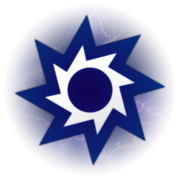Light and Dark
| This article is part of the series on |
| Vaestism |
|---|
 |
In Vaestism, Light and Dark are the mutually antithetical metaphysical forces, principles, or realms that govern all existence. Vaestic orthodoxy holds that the observable cosmos is merely a contingent projection of the interaction of the two forces, and will inevitably disintegrate over time. Human souls, too, exist natively in these realms and are merely projected as physical bodies; the goal of Vaestic practice is to achieve transcension over the two forces, and souls that fail in this goal are sundered and recombined in those hidden realms upon their deaths, to be projected anew in the process of shattering reincarnation. Though Vesnites often identify for various reasons with one over the other, both Light and Dark—to give them their conventional poetic names, the 'Terrible Light and the Unending Abyss'—are viewed as ultimately hostile, or at least apathetic, to human life. Occult practices that purport to gauge or manipulate Light and Dark without an objective and translatable empirical basis, such as the practice of metacosmology, are known in the West as amphimancy. The two principles' technical collective name, particularly in externalist contexts, is the Metacosm, from which are derived various scientific fields such as experimental metaphysics with its invention of 'metacosmic weaponry'. Where the Light is typically associated with the coolness of order, the Dark is often connected to heat and change.
The pessimistic dualism of Light and Dark appears as a novelty in the teaching of the Prophet as recorded in his Notaries, without obvious precedent either in the Messenian religion exported to Outer Joriscia by the Secotes or in native Ishtinism. Academic attempts to adduce connections to Siriash, for example by deriving the war of the two realms from the siege of Archtum, have not been widely accepted. The idea of a unifying principle that superseded both was quite popular in early Vaestism, and has more obvious Ishtinist roots: this monistic idea reached its climax in the theist Dagomah heresy of the late 15th century—originally signifying 'those who look to heaven'—which venerated the Prophet in almost classically Ishtinist terms as the supreme God. The Dagomist movement was destroyed by Nerits in the process of his conquest of Vaestdom, however, and theism of this sort fell under explicit reprobation in the orthodoxy established by the subsequent Neritsovids. A more prosaic veneration, or at least acknowledgement, of minor deities of Light and Dark, often termed demons, has survived with some degree of official toleration in folk Vaestism to the present day, but this is far from providing any explanation of the two great principles themselves.
In Vaestic orthopraxy, the human soul must be disciplined through Knowledge to be able to transcend Light and Dark. This Practice—for such is its name in the earliest texts of Vaestism, the Notaries—involves careful mystical exposure to both, with transcension representing the moment of overwhelming synthesis in which the Knowledge of the soul locks into place and the two realms' 'infinite war' is entirely surpassed. The Practice is very frequently referred to as following the 'path' that Knowledge winds between Light and Dark, which is considered to be an extremely delicate affair and was previously, before the Prophet 'broke the World-Gates', impossible. The path between Light and Dark is a common fixture of Vaestic titulary, as Emperors and Prophets invariably assert themselves to 'stand between the Light and the Dark on the path of Knowledge' (or use other phrases to similar effect), and across Vaestdom Scholars are believed to stride the path between the realms as the leaders of the common folk to whom they apport their Knowledge.